Cyanosporus subcaesia (A. David) B. K. Cui, L. L. Shen & Y. C. Dai - Blueing Bracket
Phylum: Basidiomycota - Class: Agaricomycetes - Order: Polyporales - Family: Fomitopsidaceae
Distribution - Taxonomic History - Etymology - Identification - Culinary Notes - Reference Sources
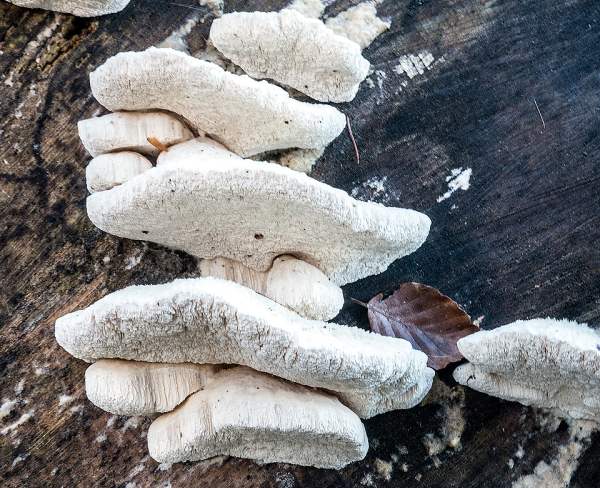
Pale at first, this annual bracket fungus, which can appear singly or in rows or tiers, turns blueor blue-grey, most noticeably on its upper surface, as it ages.
Dead wood from broadleaf trees such as oaks, beeches and alders are the staple diet of this wood-rotting fungus.
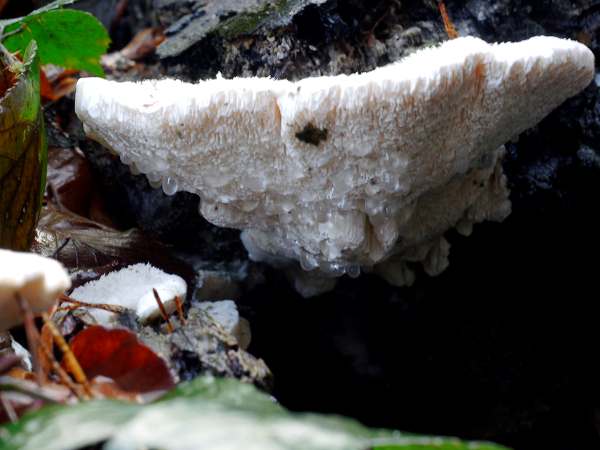
Distribution
Widespread and fairly common in Britain (rather more common in southern England) and in Ireland, Cyanosporus subcaesia is found throughout most of mainland Europe but is most common in central and northern Europe. This species is also recorded in parts of Asia.
Taxonomic history
This bracket fungus was described scientifically in 1974 by French (?) mycologist Alix David, who established its basionym when he gave it the binomial name Tyromyces subcaesius. The Blueing Bracket was transferred to its present genus in paper published in Persoonia in 2019 by B. K. Cui, L. L. Shen & Y. C. Dai, at which point its scientific name became Cyanosporus subcaesius..
Synonyms of Cyanosporus subcaesius include Tyromyces subcaesius A. David, Oligoporus subcaesius (A. David) Ryvarden & Gilb., Postia subcaesia (A. David) Jülich, and Spongiporus subcaesius (A. David) A. David.
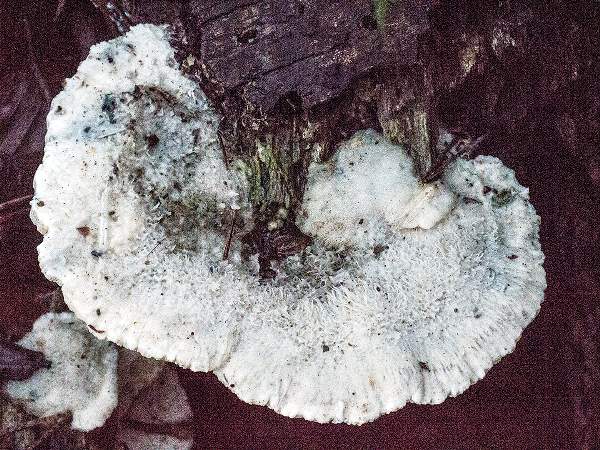
Etymology
Postia, the genus name, comes from the Latin noun postal, meaning a place. The specific epithet subcaesia means faintly sky blue and is a reference to the colour of the upper (infertile) surface of mature specimens of this bracket fungus.
Identification Guide
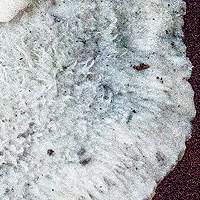 |
CapThe roughly semicircular fruitbodies are typically 1 to 5cm across and up typically 2 to 3cm thick, and the upper surface is covered in fine hairs and radial wrinkles that create a slightly wavy margin. The upper surface is white initially but develops a blue-grey tinge, especially towards the margin, as it matures. Often in fusing overlapping rows and tiers. Flesh white, fibrous. |
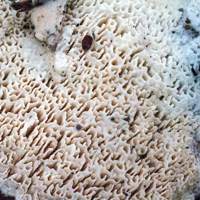 |
Tubes and PoresThe rounded, elongated slit-like or labyrinthine pores are whitish, 3 to 5mm deep, and spaced 5 to 6 per mm. |
SporesCylindrical to allantoid (sausage-shaped), smooth, 4.5-5.5 x 1-1.5µm; inamyloid. Spore printWhite or very faintly pale blue. |
|
Odour/taste |
Not distinctive. |
Habitat & Ecological role |
The Blueing Bracket is saprobic mainly on the well rotted dead wood of hardwood trees including Quercus, Fraxinus, Fagus, Corylus and Betula. |
Season |
Brackets are visible throughout most of the year, but they release their spores in late autumn. |
Similar species |
Postia caesia is similar and grows of dead conifer timber in wet locations. Postia alni is very similar and occurs on dead wood of broadleaf trees; it produces smaller brackets with a much less hairy upper surface, but even some experts continue to question whether this is a species truly distinct from Cyanosporus subcaesius. |
Culinary Notes
These bracket fungi are generally considered to be edible.
Reference Sources
Mattheck, C., and Weber, K. Manual of Wood Decays in Trees. Arboricultural Association 2003.
Fascinated by Fungi, 2nd Edition, Pat O'Reilly 2016, reprinted by Coch-y-bonddu Books in 2022.
BMS List of English Names for Fungi
Dictionary of the Fungi; Paul M. Kirk, Paul F. Cannon, David W. Minter and J. A. Stalpers; CABI, 2008
Taxonomic history and synonym information on these pages is drawn from many sources but in particular from the British Mycological Society's GB Checklist of Fungi.
Acknowledgements
This page includes pictures kindly contributed by Barry Gall.
Fascinated by Fungi. Back by popular demand, Pat O'Reilly's best-selling 450-page hardback book is available now. The latest second edition was republished with a sparkling new cover design in September 2022 by Coch-y-Bonddu Books. Full details and copies are available from the publisher's online bookshop...

